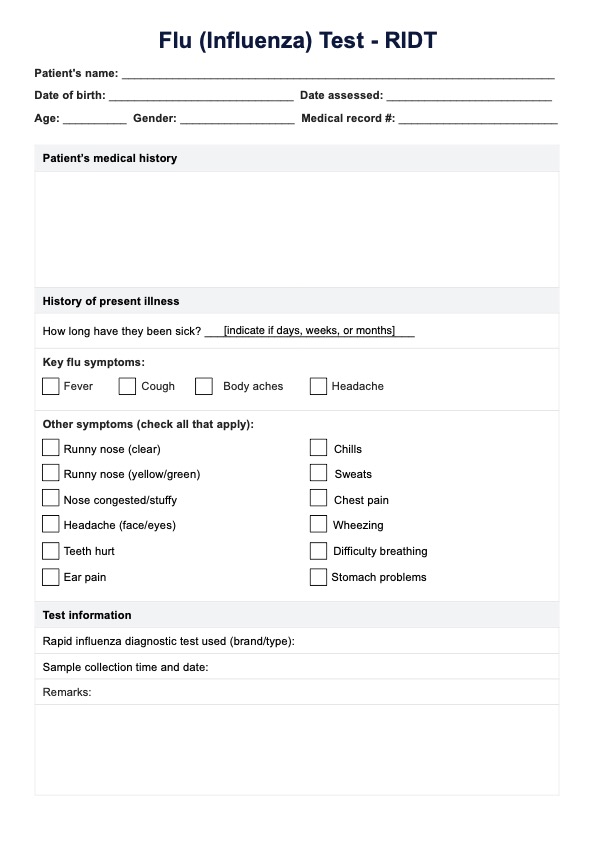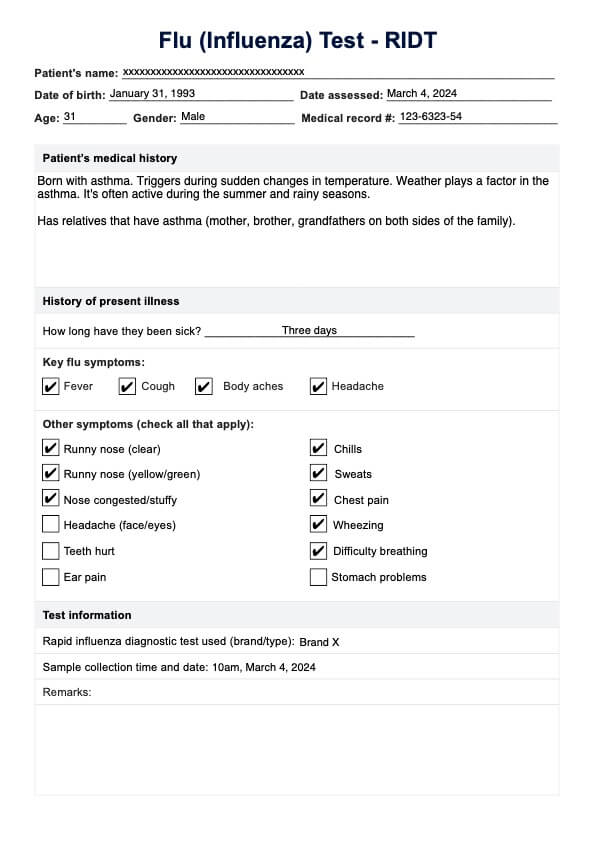Flu (Influenza) Test - RITD
Learn about basic flu tests and use our template to record RIDT results!


What is a Flu (Influenza) Test?
Flu tests, sometimes called influenza tests, are diagnostic examinations to determine if a person is infected with an influenza virus.
People with respiratory issues undergo flu tests to determine if a flu virus causes their respiratory infection. Respiratory issues share symptoms like coughs (sometimes severe), runny or stuffy noses, and sore throat. There are different kinds of flu tests, but the most common types of flu tests are the following:
Rapid influenza diagnostic tests (RIDTs)
These are sometimes called rapid influenza antigen tests (not to be confused with the kind meant for detecting COVID-19, but some test kits account for both flu and COVID-19) A rapid flu test is a nasal or throat swab test, and it involves getting a sample from the nostrils or the upper part of the throat. It produces results quickly, usually between ten to thirty minutes. It can even be self-administered.
Please note that rapid tests can yield false negative results, especially if not done correctly. Also, these tests only detect Influenza A and B.
Reverse transcription-polymerase chain reaction (RT-PCR)
This test involves getting a sample from the nostril and/or mouth. However, it'll be performed by a healthcare professional. They will take the sample and analyze it in the lab to check for influenza. Getting results for this may take a couple of hours or even a day after the test.
Flu (Influenza) Test - RITD Template
Flu (Influenza) Test - RITD Example
How are rapid influenza diagnostic tests conducted?
The test proper
Whether a healthcare professional or a non-healthcare professional is conducting rapid flu testing, the test procedure is as follows:
- Prepare the buffer tube
- The RIDT kit should come with a small vial of fluid. Place the fluid in the buffer tube
- Close the buffer tube and keep it ready
- Insert a collection swab into your nostril
- Rotate the swab three to four times against the nasopharyngeal surface
- Leave the swab in there for ten seconds so that it has enough time to gather a sample
- Open the buffer tube and dip the collection swab into the fluid
- Stir the swab at least ten times
- Press the nozzle cap of the buffer tube tightly, then close the buffer tube
- Apply at least four drops of the sample into the well of the test strip/device that came with the kit
- Wait for ten to thirty minutes for the results to show
Steps for healthcare professionals
If you're a healthcare professional, you must first do the following before conducting the RIDT:
- Collect your patient's information (name, date of birth, contact details, HMO, medical history, etc.),
- Assess their symptoms (e.g., coughing, sore throat, fever, headaches, body aches, etc.),
- And explain the RIDT to them.
Once you've done that, conduct the RIDT and then do the following:
- Interpret the findings
- Document the findings
- Create a treatment plan/preventive measures for your patient
How to interpret the results of this flu test
This rapid test has only three possible results. To determine this, one must examine the test strip/device.
Test strips/devices for RIDT have three letters:
- C, which stands for control
- A, which stands for Influenza A (the type that affects both animals and humans and is responsible for pandemics)
- B, which stands for Influenza B (the type that only passes from person to person)
If lines appear under C and A, the patient is positive for Influenza A. Meanwhile, if lines appear under C and B, the patient is positive for Influenza B. Lastly, if a line appears under C, but no lines appear under A or B, the patient is negative for Influenza.
The test was not done correctly if a line didn't appear under C. If this is the case, the test needs to be repeated.
When is it best to conduct an RIDT flu test?
The best times to conduct an RIDT Flu Test include:
Self-testing for self-quarantine
In case of outbreaks, people can self-test themselves using RIDT Flu Test kits, especially if they have no choice but to go out for work or to buy essentials. If they test positive, they can use more kits as the days pass to monitor themselves.
When testing patients for respiratory problems:
As mentioned earlier, Influenza shares many symptoms with other respiratory issues, such as colds, headaches, coughs, sore throats, fever, and more. To rule out other respiratory issues or Influenza, healthcare professionals conduct flu tests such as the RIDT to cover all possible bases before diagnosing Influenza or developing a treatment plan.
Making preventive measures
Speaking of testing patients, if a person is confirmed to have flu after testing, healthcare professionals can work to isolate the infected patient and treat them accordingly to prevent the flu from spreading.
It can be conducted to monitor patients and the spread of the virus
Flu tests can be conducted repeatedly to monitor those who have flu. Monitoring tests are vital for disease control. With proper treatment and rest, the flu should go away in time, and one way to check is to conduct RIDT or another flu test.
In case of an influenza outbreak, testing can be done to monitor the number of people with the flu and how fast it spreads among the population.
Commonly asked questions
It can be self-administered, and you can get results almost immediately. However, it has a higher chance of yielding false positive or negative results than RT-PCR tests. That doesn’t mean that RIDT Flu Tests are unreliable. If the symptoms are evident after getting a positive result, you can trust it.
Influenza C is a mild version; those with it don’t become so ill that their daily lives are horribly affected. It also doesn’t cause epidemics or pandemics.
RIDT Flu Tests can only detect Influenza A and B. Some kits can also detect COVID-19. It is best to take an RT-PCR Test to check a patient for Influenza C.















































































































